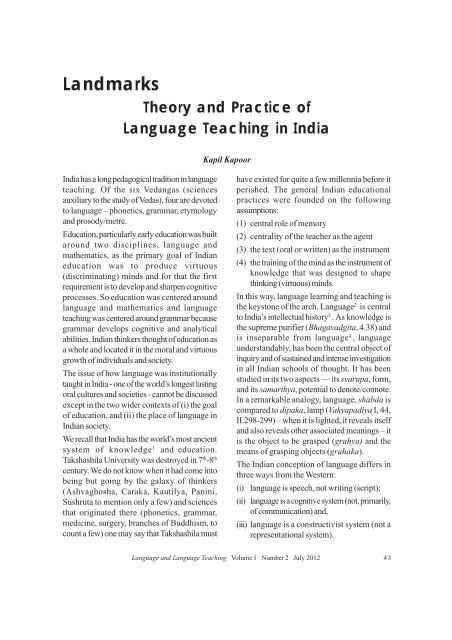Language and Language Teaching, Issue 2 - Azim Premji Foundation
Language and Language Teaching, Issue 2 - Azim Premji Foundation
Language and Language Teaching, Issue 2 - Azim Premji Foundation
Create successful ePaper yourself
Turn your PDF publications into a flip-book with our unique Google optimized e-Paper software.
L<strong>and</strong>marksTheory <strong>and</strong> Practice of<strong>Language</strong> <strong>Teaching</strong> in IndiaKapil KapoorIndia has a long pedagogical tradition in languageteaching. Of the six Vedangas (sciencesauxiliary to the study of Vedas), four are devotedto language – phonetics, grammar, etymology<strong>and</strong> prosody/metre.Education, particularly early education was builtaround two disciplines, language <strong>and</strong>mathematics, as the primary goal of Indianeducation was to produce virtuous(discriminating) minds <strong>and</strong> for that the firstrequirement is to develop <strong>and</strong> sharpen cognitiveprocesses. So education was centered aroundlanguage <strong>and</strong> mathematics <strong>and</strong> languageteaching was centered around grammar becausegrammar develops cognitive <strong>and</strong> analyticalabilities. Indian thinkers thought of education asa whole <strong>and</strong> located it in the moral <strong>and</strong> virtuousgrowth of individuals <strong>and</strong> society.The issue of how language was institutionallytaught in India - one of the world’s longest lastingoral cultures <strong>and</strong> societies - cannot be discussedexcept in the two wider contexts of (i) the goalof education, <strong>and</strong> (ii) the place of language inIndian society.We recall that India has the world’s most ancientsystem of knowledge 1 <strong>and</strong> education.Takshashila University was destroyed in 7 th -8 thcentury. We do not know when it had come intobeing but going by the galaxy of thinkers(Ashvaghosha, Caraka, Kautilya, Panini,Sushruta to mention only a few) <strong>and</strong> sciencesthat originated there (phonetics, grammar,medicine, surgery, branches of Buddhism, tocount a few) one may say that Takshashila musthave existed for quite a few millennia before itperished. The general Indian educationalpractices were founded on the followingassumptions:(1) central role of memory(2) centrality of the teacher as the agent(3) the text (oral or written) as the instrument(4) the training of the mind as the instrument ofknowledge that was designed to shapethinking (virtuous) minds.In this way, language learning <strong>and</strong> teaching isthe keystone of the arch. <strong>Language</strong> 2 is centralto India’s intellectual history 3 . As knowledge isthe supreme purifier (Bhagavadgita, 4.38) <strong>and</strong>is inseparable from language 4 , languageunderst<strong>and</strong>ably, has been the central object ofinquiry <strong>and</strong> of sustained <strong>and</strong> intense investigationin all Indian schools of thought. It has beenstudied in its two aspects — its svarupa, form,<strong>and</strong> its samarthya, potential to denote/connote.In a remarkable analogy, language, shabda iscompared to dipaka, lamp (Vakyapadiya I, 44,II.298-299) – when it is lighted, it reveals itself<strong>and</strong> also reveals other associated meanings – itis the object to be grasped (grahya) <strong>and</strong> themeans of grasping objects (grahaka).The Indian conception of language differs inthree ways from the Western:(i) language is speech, not writing (script);(ii) language is a cognitive system (not, primarily,of communication) <strong>and</strong>,(iii) language is a constructivist system (not arepresentational system).<strong>Language</strong> <strong>and</strong> <strong>Language</strong> <strong>Teaching</strong> Volume 1 Number 2 July 2012 43
















